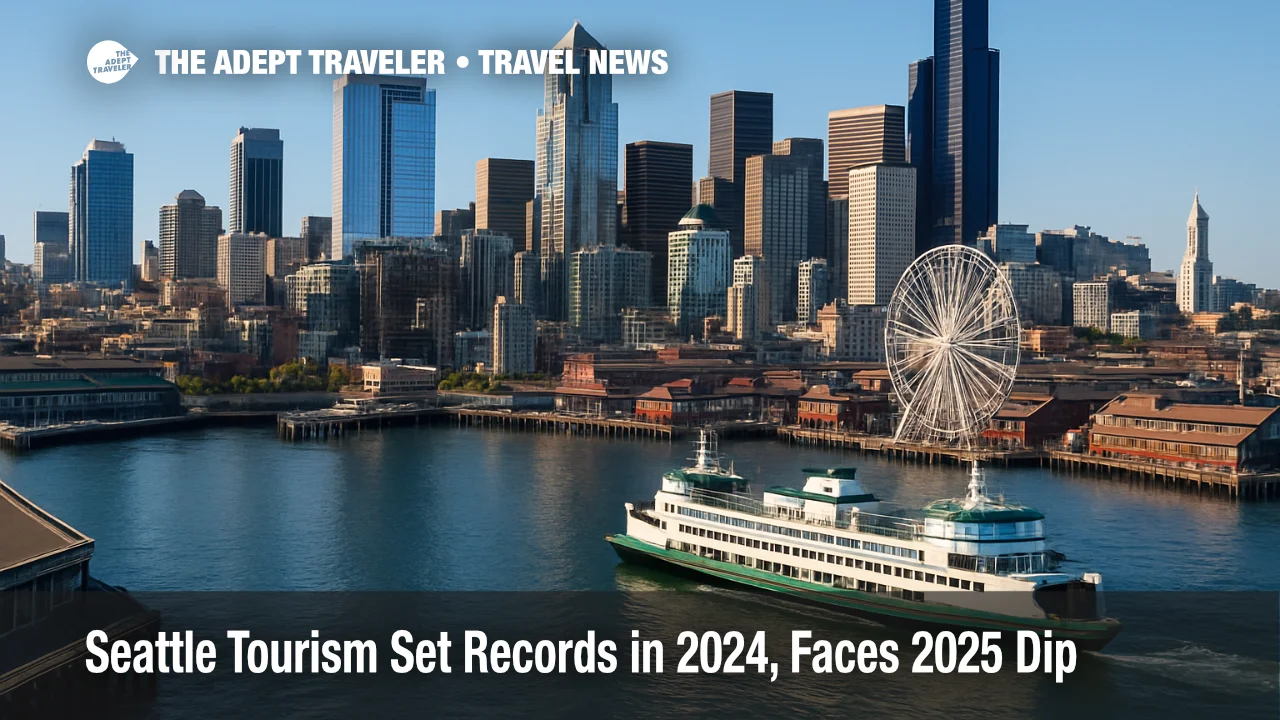Seattle tourism set records in 2024, faces 2025 dip

Seattle logged a banner 2024 for international travel, welcoming 2.4 million overseas visitors and generating $8.8 billion in total visitor spending. Canada led with 1.7 million travelers, while China and India rounded out the top three source markets. New 2025 forecasts, however, point to a steep pullback in international overnights for Seattle, driven overwhelmingly by fewer Canadian trips. Officials are leaning on new air routes and mega-event demand to rebuild momentum into 2026.
Key points
- Why it matters: International demand fuels year-round hotel, dining, culture, and retail spending.
- Travel impact: Forecasts show a 2025 decline in international overnights, led by fewer Canadian visitors.
- What's next: Added long-haul routes and FIFA World Cup matches aim to lift 2026 demand.
- 2024 marked 2.4 million international visitors and $970 million in overseas spend.
- Canada delivered 73 percent of international visits and $585.6 million in spend.
Snapshot
Tourism Economics' finalized 2024 data show Seattle's recovery accelerating. International visitation reached 2.4 million, led by 1.7 million Canadians, with China at 106,200 and India at 74,700. Overseas travelers spent $970 million, part of an $8.8 billion total visitor-spend figure that was up 7.2 percent from 2023 and 8.3 percent above 2019 levels. Canada alone accounted for $585.6 million. Early 2025 indicators and a new forecast suggest international overnight visitation could fall 26.9 percent, almost entirely due to fewer Canadian trips amid broader national headwinds, though Washington state impacts look somewhat milder on a per-capita basis.
Background
Visit Seattle's latest release underscores both strength and concentration risk. The city's global mix is diversifying, with India's climb into the top three, and steady contributions from the United Kingdom, South Korea, Germany, Japan, Australia, France, and Taiwan. Still, the market remains highly exposed to cross-border day and overnight flows from Canada, which shaped 2024 volume and now dominate 2025 downside scenarios. Nationwide, international spending is projected to soften, reflecting policy friction, visa processing constraints, and currency dynamics that make U.S. trips pricier. Seattle's response blends route development, event activation, and targeted international marketing designed to broaden demand and reduce single-market exposure.
Latest developments
2025 headwinds concentrate on Canada, policy, and processing
Tourism Economics projects a 26.9 percent year-over-year decline in international overnight visitation to Seattle in 2025, the steepest among major U.S. markets, with 99 percent of the drop tied to reduced Canadian travel. The local cross-border story aligns with national trends that cite a strong dollar, shifting political sentiment, and tighter entry protocols as demand drags. Washington state is expected to see a smaller decline of about 20 percent in Canadian visitor spending, roughly $10 per capita, indicating regional exposure but not the most severe impacts among border states. For hotels and attractions, softer shoulder-season Canadian trips present near-term revenue risk.
2026 air service adds lift, led by Copenhagen and Hong Kong
Seattle-Tacoma International Airport (SEA) continues to rebuild and expand long-haul connectivity. Scandinavian Airlines restored Copenhagen service in May 2025 and is slated to operate again next summer, anchoring Northern Europe links. Cathay Pacific will return Seattle to Hong Kong service from March 30, 2026, restoring a key transpacific gateway. Port of Seattle planning indicates more than 60 international routes in 2026, supporting diversified source markets and higher-yield long-haul traffic. For inbound tourism, these links aim to offset 2025 softness and position the city for stronger transatlantic and transpacific flows.
Mega-event catalyst: FIFA World Cup in 2026
Seattle and the region expect up to 750,000 visitors during FIFA World Cup 2026 activities, including matches and official fan celebrations. City and state partners view the tournament as a showcase for global audiences, with spillover trips before and after match days likely to benefit hotels, restaurants, and attractions. Coordinated transportation planning and venue readiness will be essential to convert event-week spikes into sustained reputation gains, return visitation, and broader international awareness.
Analysis
The 2024 finish line confirms Seattle's competitive fundamentals, but it also highlights concentration risk. Heavy reliance on Canadian travelers powered last year's volume, then flipped into a 2025 liability as cross-border demand weakened. Two levers can mitigate this. First, broaden market mix through aviation. The Copenhagen and Hong Kong links matter not just for seats, but for connectivity across SAS and Cathay networks into secondary European and Asian cities that already send high-spend visitors. Second, convert the FIFA platform into durable demand. Event-time compression boosts occupancy, yet the lasting value comes from content, itineraries, and partnerships that nudge fans to extend stays, explore the region, and return. On the policy front, smoothing visa processing and border experience will be pivotal; destination marketing cannot overcome friction at the door. If Seattle can execute on routes, fan engagement, and on-the-ground hospitality, the city is positioned to exit 2025 with healthier diversification and a sturdier base for international recovery.
Final thoughts
Seattle's 2024 metrics delivered a clear signal of strength, while 2025 forecasts emphasize the need to diversify beyond cross-border reliance and to ease entry friction. New long-haul routes and FIFA-driven visibility can widen the funnel, but only coordinated action across aviation, events, and guest experience will translate into repeat travel and higher yields. With deliberate execution, the city can convert temporary headwinds into long-term gains for Seattle tourism.
Sources
- Seattle welcomed over two million international visitors in 2024, Visit Seattle press release
- Visit Seattle 2025 annual meeting highlights, Visit Seattle
- Cathay Pacific returns to Seattle in 2026, Port of Seattle
- Cathay Pacific to relaunch Seattle service March 30, 2026, Cathay Pacific newsroom
- SAS launches Seattle, summer 2025, Port of Seattle
- Seattle Fan Celebration and visitor estimate of 750,000, SeattleFWC26
- Global context on 2025 foreign-visitor spending declines, Reuters
